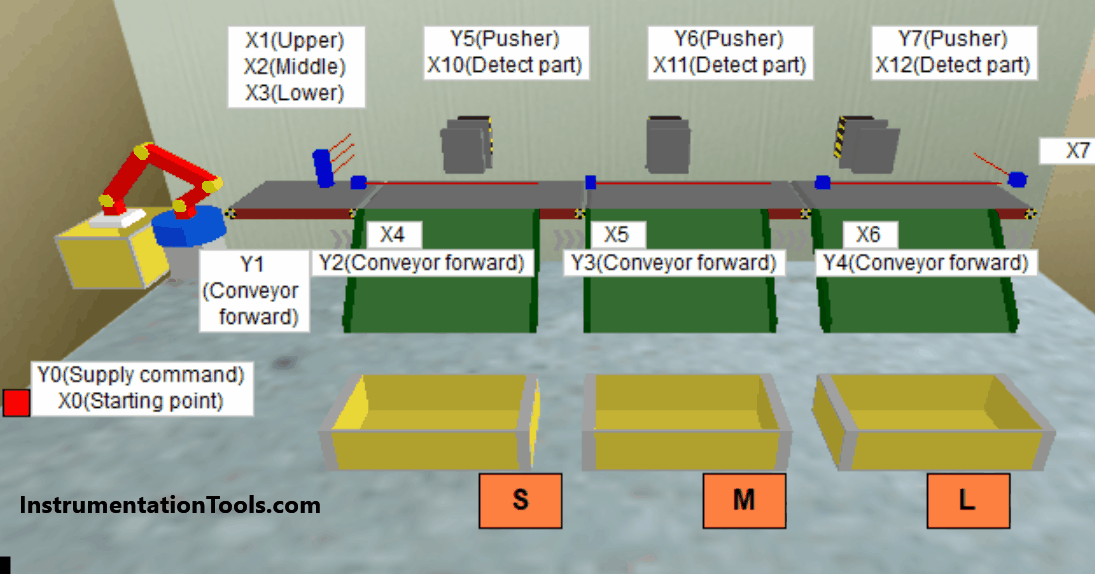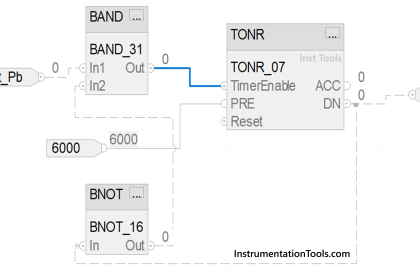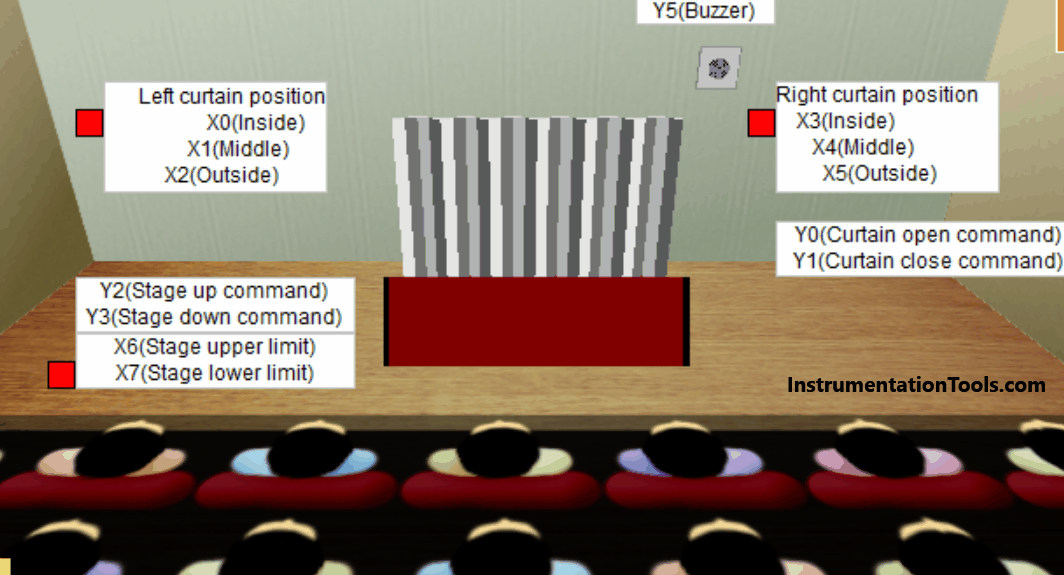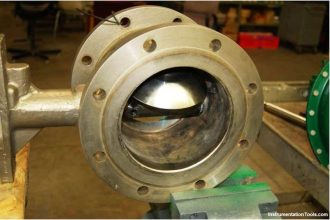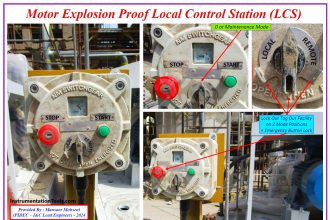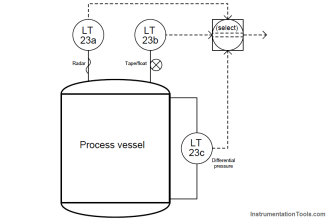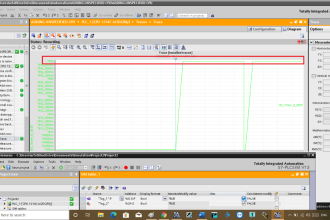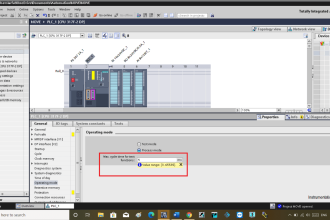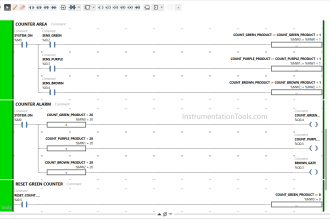PLC outputs are of two general types. They are 1. Relay and 2. Solid-state output.
Types
Relay outputs are mechanical contacts and solid state outputs may take the form of transistor or TTL logic (DC) and triac (AC).
Relay outputs are usually used to control up to 2 amps or when a very low resistance is required.
Transistor outputs are open collector common emitter or emitter follower.
This type of output can control lamps and low power DC circuitry such as small DC relays.
TTL logic outputs are available to drive logic circuitry. Triac outputs are used to control low power AC loads such as lighting, motor starters and contactors.
As with input units, output units are available with a common terminal and isolated from each other.
The type of output unit selected will depend upon the outputs being controlled and the power available for controlling those devices.
Typically, power for driving output devices must be separately provided since there can be a wide range of requirements depending upon the device.
Relay Outputs
As stated before, relay outputs are normally used to control moderate loads (up to about 2 amps) or when a very low on resistance is required.
Relay contacts are described as three main arrangements or forms. The three arrangements are FORM A, FORM B and FORM C.
A FORM A relay contact is a single pole normally open contact. This is analogous to a single contact normally open switch.
The FORM B relay contact is a single pole normally closed contact which is similar to a single normally closed switch.
FORM C relay contact is a single pole double throw contact. The schematic symbols for the three arrangement types are shown in Figure below:

Fig : Relay Contact Arrangements
PLC output units are available with all three contact arrangements but typically FORM A and FORM C are used.
By specifying a FORM C contact, both FORM A and FORM B can be obtained by using either the normally open portion of the FORM C contact as a FORM A contact or by using the normally closed portion of the FORM C contact as a FORM B contact.
Relay outputs are also available with a common terminal and as isolated contacts. An output unit with three FORM C contacts having a common terminal is shown in Figure below.
Note in this figure that the common terminal of each of the three relays is connected to one common terminal of the output unit labeled OUTPUT COM.
Since all relays have one common terminal, all power supplies (there can be one or several) associated with the outputs to be driven must have one common connection.
Note that each output has two labeled outputs, NC (normally closed) and NO (normally open). The NC and NO have a number following which is the number of the output associated with the terminal.
When an output is turned OFF, the OUTPUT COM terminal is connected to the NC terminal associated with that output. When the output is turned ON, the OUTPUT COM terminal is connected to the associated NO terminal.
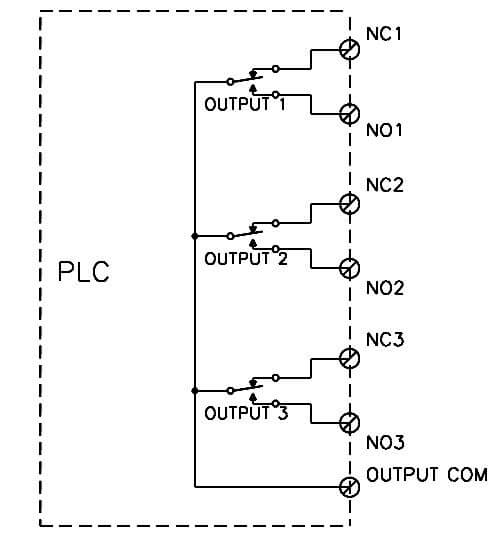
Fig : Common Relay Output
A typical connection diagram for a relay output unit with three FORM C contacts having common output is shown in Figure.
In this drawing, the power source shown is an AC supply which could be the 120VAC building power. Notice that the wiring of this figure shows lamp LT1 as only lighting when OUTPUT 1 is turned ON.
This is because the lamp is connected to the NO terminal for OUTPUT 1. Lamp LT2, however, is connected to the NC terminal for OUTPUT 3. This lamp will be ON whenever OUTPUT 3 is turned OFF.
This means that if the PLC were to lose power, lamp LT2 would light since there would be no power to energize the output relays in the PLC. In the ladder diagram, OUTPUT 3 could be programmed as an always ON coil.
The result would be that while the PLC was powered and running, lamp LT2 would not be lit. If the PLC lost power lamp LT2 would light and provide the operator with an indication that the PLC had a problem.
This method could also be provided as a maintenance tool to allow maintenance to troubleshoot and repair the system faster. Also in the drawing of Figure, a coil K1 is shown connected to OUTPUT 2.
This could be a solenoid which drives a plunger into a slide to lock it in place or it could be the coil of a motor starter used to control power to a motor which requires more current than the relay in the output unit can safely carry.
Note that to be used in this situation, the coil K1 would have to be rated for AC use at the voltage available from the AC power source.
The wiring of these outputs may each be thought of in terms of a switch controlling a lightbulb. A normally closed switch or a normally open switch may be used.
The switch is placed in series with the lightbulb and the power source to control current to the light.

Fig : Common Relay Wiring
A PLC relay output unit with three isolated FORM C contacts is shown in Figure below.
In this type output unit, the relay contacts have no connection between them. These output contacts may be used for any purpose to drive any three output devices with no concern for connection between power sources.
Each output has three terminals. The C terminal is the common terminal of the relay. The NO terminal is the normally open contact and the NC terminal is the normally closed contact of the relay.
The NC and NO terminals have a number following them that is the associated output number and the same number is indicated for each C terminal as well as indicating that it is associated with a particular output.
As with the common relay output unit of Figure of Common Relay Output, the NO contact only closes when the output is ON and the NC contact only opens when the output is ON.
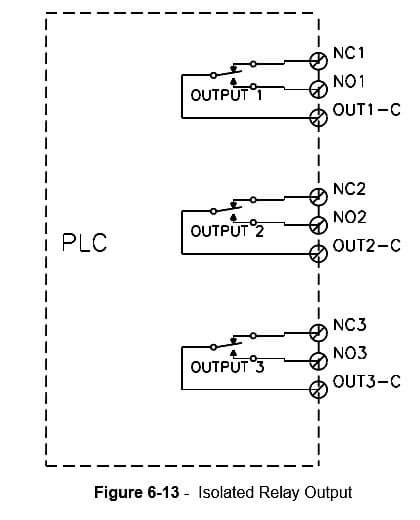
Figure below shows a typical system output wiring diagram using an output unit having three FORM C isolated outputs. In Figure below, the three outputs are controlling devices with three different power requirements.
OUTPUT 1 is controlling a DC lamp, LT1, which has it’s own DC power source. Notice that lamp LT1 will be lit whenever OUTPUT 1 is turned OFF. This could possibly be a fault indicator for the system.
Lamp LT2 is an AC lamp having it’s own AC source. LT2 is also lit when OUTPUT 3 is turned OFF. This could be used as a fault indication.
OUTPUT 2 is connected to a release valve which has an internal power source and only needs a contact closure to release. In this case, the release valve is connected to the normally closed terminal for OUTPUT 2.
This connection provides for the release valve to be in the release condition should the PLC lose power. This may be the requirement to provide for the machine being in a safe condition in case of system failure.
Notice that in the wiring of INPUT 1 and INPUT 3, the wiring provides for a power source, switch and light all in series, with the switch controlling the flow of current to the light.
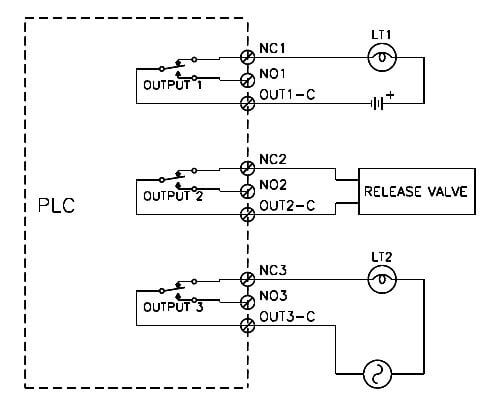
Isolated Contact Wiring
Solid State Outputs
There are several types of solid state outputs available with PLC’s. Three popular types are transistor, triac and TTL. All three of these output units will generally have a common terminal although triac output units are available in an isolated configuration.
Transistor output units are usually open collector with the common terminal connected to the emitters of all outputs.
A transistor output unit providing three open collector outputs is shown in Figure below. In most, if not all transistor output units, the transistors optically isolated from the PLC.
The transistors shown in Figure below are optically isolated devices. This unit has all the emitters of the output transistors connected to one common terminal labeled OUTCOM. The transistors contained in this unit are NPN although PNP units are available.
There are two different types of transistor units available and they are described as sourcing and sinking. The NPN units are referred to as sinking and the PNP units as sourcing.
The unit shown in Figure below contains sinking outputs. This means that the transistor is configured to sink current to the common terminal, that is, the outputs will have current flow into the terminal.
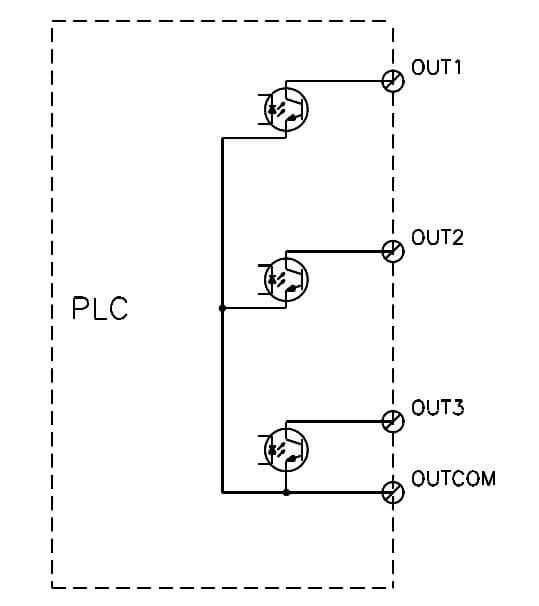
Fig : Transistor Output Unit
A sourcing type output will have current flow out of the terminal.
Another way of looking at the difference is that a sinking output will pull the output voltage in a negative direction and the sourcing output will pull the output voltage in a positive direction.
The sourcing and sinking description conforms to conventional current flow from positive to negative. A sourcing transistor output unit is shown in Figure below.
Notice that the transistors used are PNP type and that the common terminal would have to be connected to the positive terminal of the power supply for the transistor to be properly biased.
This will cause the outputs to be pulled in a positive direction when the transistor is turned ON (a sourcing output).
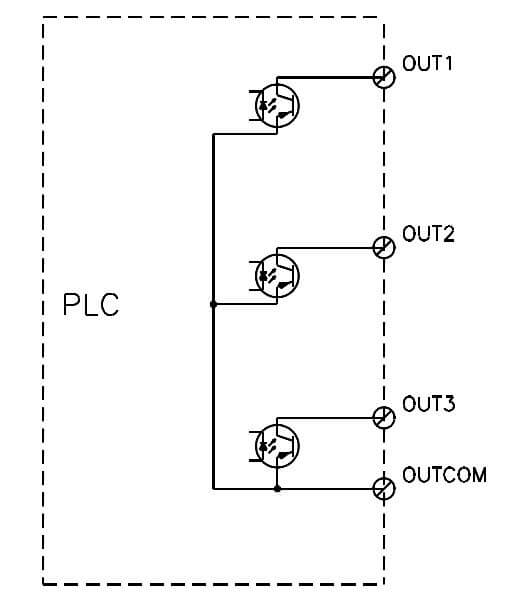
Fig : Transistor Sourcing Output
A wiring diagram for a transistor sinking output unit is shown in below.
This diagram shows three output devices connected to the output unit. Lamp LT1 will light when OUTPUT 1 turns ON since the output transistor will saturate when the output turns ON.
The saturated transistor will sink current to the OUTCOM terminal causing current to flow in the lamp. OUT2 is connected to a coil K1. This could be a solenoid or relay. This device will be energized when OUTPUT 2 is turned ON causing the output transistor to saturate.
Notice that a diode, CR1, is connected across K1 in such a manner as to be normally reverse biased. This diode prevents excessive voltage buildup across K1 when the output transistor turns OFF. When the output transistor turns OFF and the magnetic field in the coil begins to collapse, a voltage in opposition to the applied voltage is developed.
Unchecked, this voltage could be as high as several hundred volts. A voltage this high would quickly destroy the output transistor. The voltage is not allowed to build up because the current developed by the collapsing field is shunted through the diode.
Transistor output units now generally have this diode built into the output unit for protection. Also, some relays are manufactured with this diode installed. Notice, too, that the diagram of Figure below includes two separate power sources, one providing power for LT1 and the other providing power for K1 and LT2.
This is a typical situation since there may be occasions when devices connected to the output unit operate at different voltages. In this case, LT1 could be a 5 volt lamp and LT2 and K1 could be 24 volt devices.
The only requirement is that the two power supplies (PS1 and PS2) must have a common negative terminal that is connected to the OUTCOM terminal.
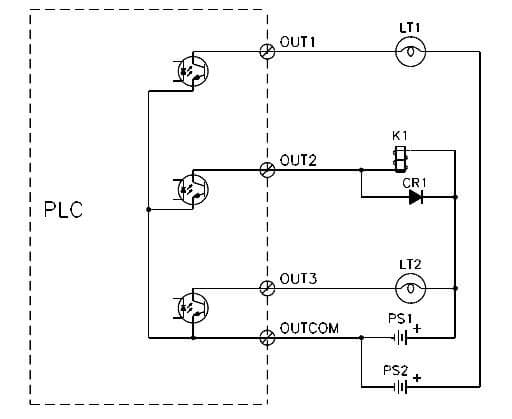
Fig : Transistor Output Wiring
Figure below contains the schematic drawing for a triac output unit. All output triacs have one common terminal which will be connected to one side of the AC power source providing power for the output devices being controlled.
Each triac is triggered when the output associated with it is turned ON. There are units available that have zero crossover networks built in to provide for noise reduction by only allowing the triac to turn ON at the time the power signal crosses through zero volts.
Noise and current spikes can be generated when the triac turns ON if the AC voltage is at some voltage other than zero since the voltage to the output device being controlled will instantly go from zero with the triac OFF to whatever the AC value of the voltage is at turn-on.
If the triac turns ON at the time the AC voltage is passing through zero volts, no such spikes will be produced. Notice that the triac outputs shown in Figure below are optically isolated from the PLC.
This allows the PLC to control very high voltage levels (120 – 240 VAC) with isolation of these voltages from the low voltage circuitry of the PLC.
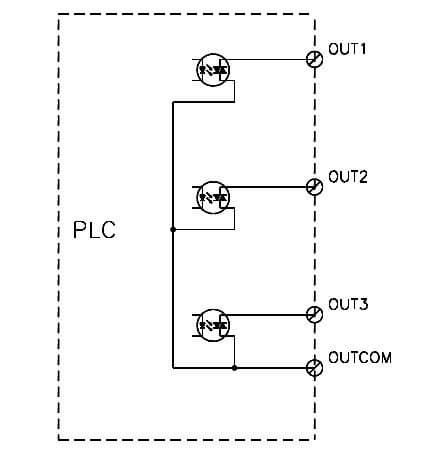
Fig : Triac Output Unit
Figure below contains the wiring diagram for a triac output unit. As can be seen in the diagram, the common terminal for the triacs is connected to one side of the AC source powering the output devices controlled by the unit.
Output units are available with different voltage and current ratings. The devices being controlled by the output unit shown in Figure below look the same as the ones in Figure of Transistor Output Wiring.
The difference is that all devices in Figure of Transistor Output Wiring are DC units and all devices in Figure below operate on AC. Also notice that the diode across K1 is not present in the triac output unit drawing.
This is because the triac turns OFF when the applied current crosses through zero volts. The result is that either a very small magnetic field is present or no magnetic field is present when the triac turns OFF and the voltage spike present in a DC system is not generally a problem.
This can still be a problem if the coil is highly inductive because the voltage and current will be so far out of phase that some voltage will still be present when the current crosses zero.
In this case a series combination of resistance and capacitance is connected in parallel with the coil. This series R-C circuit is referred to as a snubber.
The terminal of the AC source generally connected to the common terminal of the output unit is the neutral lead of the source.
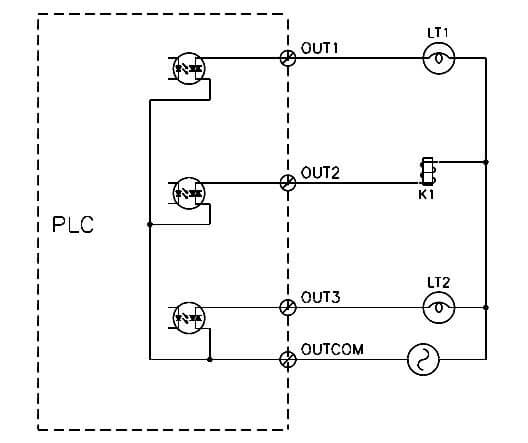
Fig : Triac Output Wiring
Figure below shows the schematic diagram of an output unit containing three TTL outputs. Notice that these outputs are also optically isolated.
In some cases these may be direct and not optically isolated but the isolated units provide better protection for the PLC. The outputs of the TTL unit have a common terminal (OUTCOM) which must be connected to the negative terminal of the power supply for the external TTL devices being driven by the output unit.
Some TTL output units require that the 5 VDC power for the output circuitry be connected to the output unit to also provide power for it’s internal TTL circuitry.
The connection of these outputs to external TTL circuitry would be the same as with any other TTL connections. The only concern with these outputs is that various PLC manufacturers specify the outputs as positive or negative logic.
How this is handled in the ladder diagram will be affected by this specification.
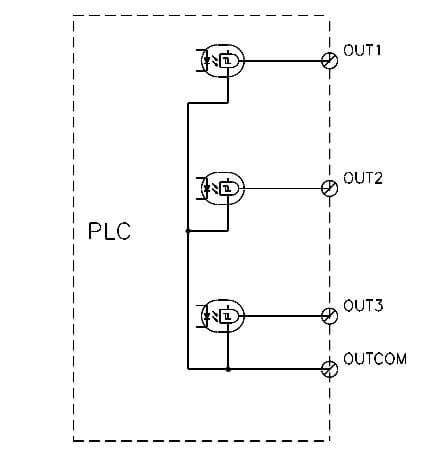
Fig : TTL Output Unit
As can be seen from the above discussion of input and output units, there are a large variety of options available.
Wiring for each type of unit is critical to the unit’s proper operation. Much care must be taken to insure proper operation of the output or input unit without causing damage.
Also, there are safety concerns which must be addressed when planning and implementing the wiring of the system to provide for a system that will not be a hazard to the people operating and maintaining it.
If you liked this article, then please subscribe to our YouTube Channel for PLC and SCADA video tutorials.
You can also follow us on Facebook and Twitter to receive daily updates.
Read Next:
- PLC Latching Function
- Electrical Signal & Control Wiring
- PLC Ladder Diagrams
- Normally Open or Normally Closed
- Relay Loop Back Circuit



